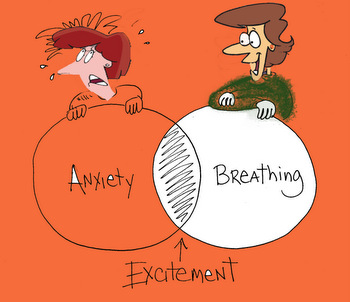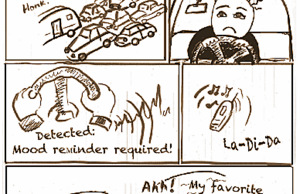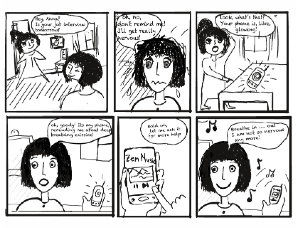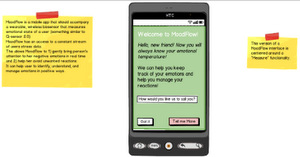MoodFlow a proof of concept
Stress level readings collected over time by your MoodFlow wearable, wireless biosensor that constantly measures your emotional state.
- What are you testing?
MoodFlow is a mobile app that accompanies a wearable, wireless biosensor, that constantly measures your emotional state. MoodFlow processes this stream of emotional data and gently brings your attention to your negative emotions, helping you to avoid unwanted reactions. It all happens in REAL TIME: sensor sends your stress level readings and MoodFlow application gets your attention by sending you a reminder. MoodFlow application also saves your emotional state readings so you can analyze them at a later, convenient for you, time. The focus of this test is a MoodFlow site user interface that allows user to access, manipulate and analyze this stress level data.
- What do you want to learn? What concerns, questions, and goals is the test focusing on?
This test will attempt to determine user friendliness of a data tracking interface of Moodfow system and answer following questions: Is it easy to locate data tracking portion of the site? How simple is it to fnd an event on a Timeline chart? Is it obvious how to modify event information? Do changes produce noticeable, obvious results?
- Where/when will the test take place? How long will it take?
To closer mimic real world use scenario this test will take place in a quiet room at a randomly assigned time of day. Testers will be sitting at the computer using Moodfow web site software. Users will be asked to time their actions, but overall test should not take more then 30 minutes of their time.
- What tasks will you ask the user to perform that will help answer your questions?
Users will be asked to locate and use the data tracking portion of a Moodfow web site. Users will need to identify an event on a Timeline chart, modify information of the found event. Users will then observe and note changes in both “Timeline” and “Locations “ charts that should result from users manipulations.
- How will your participants share their feedback? (Think aloud, questionnaire/survey, post-test interviews...)
- Users will give feedback and share their experience through a combination of of think aloud and a post-test interviews.
- This is the section of the site, that deals with previously collected user data. Please find charts showing timeline of user's stress levels, then grouped by location, where stress level readings were collected.
-
- Q1: How long did this take?
- Q2: Was the chart clearly labeled? Did toggle button use familiar language?
- On the Timeline chart Identify event recorded on May 22 2012 at 07:16 PM
- Q1: How long did this take?
- Q2: Did you wish this data point was labeled?
- Annotate this event.
- Q1: Was the annotate window easy to fnd?
- Q2: Was the editing procedure straightforward?
- Choose next event to annotate. This time create your own tag.
- Experiment with event tagging. When done, look for the data you have just created on the 'Locations' chart.
- Q1: Locations chart is displaying how frequent high stress levels occurred at a certain location a) Yes b) No
- Q2: Locations pie chart refected my new location tag a) Yes b) No
- Determine testers age, gender, education, occupation.
- Ask questions to determine how familiar is the tester with the subject of the application. For example:
- How often do you meditate a) never b) tried once c) sometimes d) at least once a week
- Mindfulness is a) when my mind is full b) Mindfulness means paying attention in a particular way: on purpose, in the present moment, and non judgmentally. c) bringing one’s complete attention to the present experience on a moment-to- moment basis
"The mind is malleable, our life can be greatly transformed by even a minimal change in how we manage our thoughts and perceive and interpret the world. Happiness is a skill. It requires effort and time."
- Step 1: observe
- I observed how my family, relatives,
friends and strangers handle their daily emotions. Ok, so we need all the help we can get!
I would love to come up with a gadget / application which could help
all of us to better the way we react, manage our emotions, use technology to facilitate personal change.
Point of View:
Negative emotions are a part of life, but it does not mean that we should let them take over our lives. Lets create an electronic “Assistant”, that can prompt us to become aware of our own emotions, deepen our self-awareness, enhance our Emotional Intelligence. - Anxiety
-

Anna
Most of us have heard by now how deep breathing helps with anxiety, but do we remember to do it when it matters? When we are in a middle of an anxiety prompting situation? Here is Anna nervous before a doctor appointment. Visiting doctor's office had always made her anxious. If only Anna could remember to breath! If only Anna could remember to NOTICE her emotion. Sally is in the room with Anna, she reminds Anna about the breathing trick and helps her relief the stress - Annoyance
-
- Agitation
-
- Step 2: Needs
-
- Anna needs to notice onset of anxiety and remember a helpful exercise.
- Boris wants to manage his road rage. He would like to be able to stop his destructive emotions before they take over.
- Sally is very sad after a confrontation, but she just can't stop herself when she is in the middle of a conflict.
- Anna, Boris & Sally, me and likely many others have these common goals - we would love to minimize our negative emotions, relieve stress, become happier!
- Step 3: Goals / Tasks
-
- Neuroscientists and Buddhist tradition are in agreement that it is possible to train our minds in habits of well-being. Which, in turn, will bring us closer to these goals. One of the existing models with promising self-awareness enhancement results is an Emotional Intelligence model.
- What is EI? Emotional Intelligence is the ability to identify, use, understand, and manage emotions in positive ways to relieve stress, communicate effectively, empathize with others, overcome challenges, and diffuse conflict. Emotional intelligence impacts many different aspects of our daily lives, such as the way we behave and the way we interact with others.
- First step in developing, deepening EI is learning to perceive emotions, acquiring an ability to recognize them. Anna & Co needs an “Assistant”, that can prompt her to become aware of her own emotions.
- technologies for measuring emotional response:
- Sympathetic Nervous System measurement
- Automated Facial Expression Recognition
- Wearable electrocardiograph (ECG) monitoring system
- An emotion sensing platform containing an ear clip photoplethysmograph sensor. This sensor measures the blood volume pulse of the ear lobe, etc.
- use location services and/or accelerometer for spacial/situational awareness: i.e. the user is driving, at work, at home etc.
- use audio sensor for situational evaluation: the voices are razed, the pitch just changed, etc.
- After the unwanted emotion is detected we need to have a system of reminders, alerts and cues that can help a person notice and recognize her emotion. Possible scenarios:
- send out an SMS
- generate a phone call
- play a tune
- display an image
- change an LED color, blinking pattern
- discrete buzz
- connect to friends
- “Assistant” should react as desired, i.e. alert the user in a previously established way. For example, Boris should be able to configure the system in a way that, when next time he gets aggravated while driving “Assistant” will start playing his favorite song. However when getting into a heated argument with Sally he should get a phone call, giving him enough time and opportunity to react in a non-confrontational manner.
- Statistically most “change” resolutions fail. Change is hard and requires effort and attention. An element of surprise, sense of novelty are known to naturally help sustain attention and interest. Randomize reminders.
- Make it into a game: satisfy the need for gratification, provide positive feedback when task is accomplished, a negative emotion is managed.
- Provide support network – have a community of people who are dealing with the same issues. Provide privacy.
- Some times reminders are not enough - helpful solutions, depending on the circumstances, a bag of tricks to alleviate stress are needed.
- Allow people to track their progress, or analyze failures – collect “emotional reaction” data and provide an insightful way to visualize it.
Use available technology to identify these emotions as they emerge. Possibilities:
- Point of View
- Negative emotions are a part of life, but it does not mean that we should let them take over our lives. Lets create an electronic “Assistant”, that can prompt us to become aware of our own emotions, deepen our self-awareness, enhance our Emotional Intelligence.
- Storyboard I
-
- Storyboard II
-
- MoodFlow Mockup I
-
- MoodFlow Mockup II
-





